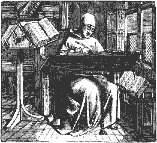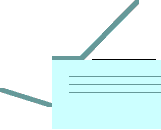 "What is Physics Good For?"
"What is Physics Good For?"
Extra credit is available at the end of this page. Please respond before 9 AM, Monday, October 2nd, 2000.

Photocopiers
 Physics is good for developing (and understanding) new technologies that allow people to do things they could not do before. One technology that we take for granted is the ability to make a good copy of a document. 100 years ago, this was impossible. The only way to make a copy of a document was to pay a scribe to rewrite. If the document included a drawing, then you needed an artist as well. The ability to make photocopies is as important an innovation as the invention of the printing press by
Johannes Gutenburg in the mid fifteenth century.
Physics is good for developing (and understanding) new technologies that allow people to do things they could not do before. One technology that we take for granted is the ability to make a good copy of a document. 100 years ago, this was impossible. The only way to make a copy of a document was to pay a scribe to rewrite. If the document included a drawing, then you needed an artist as well. The ability to make photocopies is as important an innovation as the invention of the printing press by
Johannes Gutenburg in the mid fifteenth century.
Try to imagine what the following actions would cost, in time and money, if you could not make copies for a nickel.
- Prove that you already paid your phone bill.
- Give 20 people a map to your house.
- Provide 50 students with a calendar of subjects and assignments in a college course.
- Inform all the employees of a large corporation about a change in business policy.
There can be little doubt, the ability to make "photocopies" of important documents has made expensive communications cheap, and impossible communications possible. So, what does go on inside the copier? There are two key steps that involve distributing charge on an insulating surface. As you have read in the book, an insulator is a material that can hold electric charges in place. In particular, charge can be placed onto paper in a complicated pattern, including the shapes of letters or pictures. Since paper is an insulator, the charge will stay where it is put.

Here are the basic steps in the photocopying process.
- A surface called the "platen" is uniformly coated with charge. That is, it holds a uniform "surface charge density."
- An image of the document to be copied is shined on the platen. Wherever the light is bright, the surface charge drains away (the platen is "photoconductive" is becomes a conductor when light shines on it).
This leaves a pattern of charge on the platen just like the pattern of light and dark areas on the document.
- Next, "toner" is swept over the platen. The toner is composed of tiny ink particles. The electric field of the platen induces a charge on the toner particles, thus attracting them to the charged areas.
- The paper is given a surface charge and placed against the platen.
- The toner adheres to the paper, and is fused on at high tmeperature.
The man behind this technology is an amazing story in his own right. Chester F. Carlson was born in Seattle Washington in 1906. His father, a barber, had severe arthritis, and Chester became the primary breadwinner in his family by the age of 14. However, Carlson did manage to put himself through college. He started out at a junior college, then transfered to the California Institue of Technology. He graduated with a B.S. in Physics in 1930. The depression was in full swing, and after applying to 82 companies Carlson had zero job offers. He eventually got hired by Bell Labs in New Jersey, but he was laid off soon thereafter. He got a job with the P. R. Mallory (of battery fame) in the patents department. The story goes that Carlson was frustrated by the time and expense of making duplicate copies of patent applications. He began working to find a way to circumvent this process, and the result, ultimately, was the photocopying process. But the road was long. More on this story can be found in the links at the end of this page.
A brief history of photocopying
- 1906 Chester F. Carlson is born. Also, the Haloid Company is founded in Rochester, N.Y.
- 1958 The Haloid Company changes its name to Haloid Xerox, Inc.
- 1959 The first plain paper office copier is announced, the Xerox 914.
- 1961 Haloid Xerox changes its name to Xerox corporation, and is listed on the New York Stock Exchange.
- 1968 Death of Chester Carlson
- 1976 The last Xerox 914 is sold.
- 1988 2 millionth XEROX copier produced
You can get a lot more information about this subject on the internet. Here are a few search engines
1. Alta Vista
2. Google
3. Northern Light
4. Ask Jeeves
5. Infoseek
And here are a few good links to get you started.
1.

 2.
2.

 3.
3.

Research Questions (1 point extra credit each!)
- What is the origin of the word "xerography"?
- Where and when did Carlson build the first photocopy machine?
- How long a time passed between the invention of the machine and the time a company decided to try to make them.
- Did Chester Carlson get rich?
This site is made possible by funding from the National Science Foundation (DUE-9981111).
©2001 A. Gavrin and G. Novak, all rights reserved.
|



 "What is Physics Good For?"
"What is Physics Good For?"

 Physics is good for developing (and understanding) new technologies that allow people to do things they could not do before. One technology that we take for granted is the ability to make a good copy of a document. 100 years ago, this was impossible. The only way to make a copy of a document was to pay a scribe to rewrite. If the document included a drawing, then you needed an artist as well. The ability to make photocopies is as important an innovation as the invention of the printing press by
Physics is good for developing (and understanding) new technologies that allow people to do things they could not do before. One technology that we take for granted is the ability to make a good copy of a document. 100 years ago, this was impossible. The only way to make a copy of a document was to pay a scribe to rewrite. If the document included a drawing, then you needed an artist as well. The ability to make photocopies is as important an innovation as the invention of the printing press by
